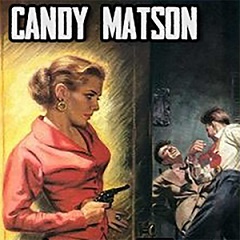
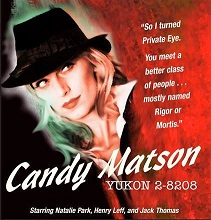 Candy Matson (1949-1951) aired “Valley of the Moon” on December 26, 1949 as the 26th of its estimated 92 shows (some accounts give 93 as the number, including a pilot that aired over a year later in hopes of sparking a revival that never took place). Candy Matson is a smart, self-sufficient, female detective. Everyone is familiar with all of the police or detective shows featuring a male detective, sleuth, or investigator (some in the superhero vein). There was The Saint, Sherlock Holmes, Nick Carter, Sam Spade, Philip Marlowe, Nero Wolfe, Jeff Regan (starring Jack Webb), Dragnet (again starring Jack Webb), Philo Vance, Johnny Dollar, The Green Hornet, The Shadow, and many, many others. One estimate runs to 120 OTR detective/police shows featuring a male lead. But not only were there Private Eyes on radio, there were Private Eyelashes as well, as early as the late 1930s and well into the 1940s (Kitty Keene, Carolyn Day-Detective, Miss Pinkerton, Meet Miss Sherlock, and Police Woman, to name a few). Though short lived (it never had a sponsor, advertisers were jumping on early television to promote their products), Candy Matson was one of the most popular radio shows west of the Mississippi and especially in San Francisco.
Candy Matson (1949-1951) aired “Valley of the Moon” on December 26, 1949 as the 26th of its estimated 92 shows (some accounts give 93 as the number, including a pilot that aired over a year later in hopes of sparking a revival that never took place). Candy Matson is a smart, self-sufficient, female detective. Everyone is familiar with all of the police or detective shows featuring a male detective, sleuth, or investigator (some in the superhero vein). There was The Saint, Sherlock Holmes, Nick Carter, Sam Spade, Philip Marlowe, Nero Wolfe, Jeff Regan (starring Jack Webb), Dragnet (again starring Jack Webb), Philo Vance, Johnny Dollar, The Green Hornet, The Shadow, and many, many others. One estimate runs to 120 OTR detective/police shows featuring a male lead. But not only were there Private Eyes on radio, there were Private Eyelashes as well, as early as the late 1930s and well into the 1940s (Kitty Keene, Carolyn Day-Detective, Miss Pinkerton, Meet Miss Sherlock, and Police Woman, to name a few). Though short lived (it never had a sponsor, advertisers were jumping on early television to promote their products), Candy Matson was one of the most popular radio shows west of the Mississippi and especially in San Francisco.
We have previously showcased but five of the 14 surviving Candy Matson episodes, the first back in March of 2017, two from 2018–August and December, one in January of 2021 and the last over a year ago in February of 2022. For those not familiar with those widely spaced episodes and the show’s interesting history (a female detective, a veiled gay character, etc.), I am reprising below (with minor alterations) from the original introductory notes:
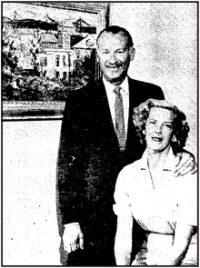 Candy Matson was the brainchild of Monty Masters. Originally conceived as a private investigator program set in San Francisco with a male lead, Masters’ mother-in-law convinced him to feature a female private eye. Masters then turned to his wife Natalie Masters (the former Natalie Park, 1915-1986: photo at left, Monty and Natalie, May 1957) to play the lead role, for which her real life personality was made. Candy Matson lived life to its fullest. A former actress who gave it all up for the life of a private detective, she now resides in a penthouse atop San Francisco’s famed Telegraph Hill. Throughout various episodes we learn that she loves her furs, sunbathing on her patio, listening to 49ers football games while sipping martinis, and pretty much her overall luxurious lifestyle. She never compromises in deference to her sexuality, and is a much sought after investigator–-as her high-end fees can attest. About her love of cash, Candy quips that it is needed to keep the “moths out of a few mink coats.” Candy had two recurring supporting characters in her adventures, handsome police Lieutenant Ray Mallard (with whom she has more than a professional relationship as the series progresses and as his character becomes more suave and alluring with each episode), and her best friend Rembrandt Watson, a single, middle-aged, flamboyant fashion photographer who enjoys the opera. Even though San Francisco had the largest gay community of any American city after World War II, and the show was set in the City by the Bay, network radio in the 40s and 50s would not allow an openly gay character to appear on the air, but Masters’s scripts managed to suggest as much, and the actor who played Watson, Jack Thomas (stage name for Natalie’s real life uncle), added a slightly feminine air to his characterization as time went on. After listening to several of the 14 extant episodes, it is easy to understand the popularity of Candy Matson. Natalie Masters plays her perfectly: saucy, sexy, smart, hard as nails when need be, and unapologetic and fully embracing her chosen lifestyle. A woman for the ages it would seem and ahead of her time. Natalie Masters would go on to have roles in several films and numerous episodes of popular tv shows, several of which are shown below.
Candy Matson was the brainchild of Monty Masters. Originally conceived as a private investigator program set in San Francisco with a male lead, Masters’ mother-in-law convinced him to feature a female private eye. Masters then turned to his wife Natalie Masters (the former Natalie Park, 1915-1986: photo at left, Monty and Natalie, May 1957) to play the lead role, for which her real life personality was made. Candy Matson lived life to its fullest. A former actress who gave it all up for the life of a private detective, she now resides in a penthouse atop San Francisco’s famed Telegraph Hill. Throughout various episodes we learn that she loves her furs, sunbathing on her patio, listening to 49ers football games while sipping martinis, and pretty much her overall luxurious lifestyle. She never compromises in deference to her sexuality, and is a much sought after investigator–-as her high-end fees can attest. About her love of cash, Candy quips that it is needed to keep the “moths out of a few mink coats.” Candy had two recurring supporting characters in her adventures, handsome police Lieutenant Ray Mallard (with whom she has more than a professional relationship as the series progresses and as his character becomes more suave and alluring with each episode), and her best friend Rembrandt Watson, a single, middle-aged, flamboyant fashion photographer who enjoys the opera. Even though San Francisco had the largest gay community of any American city after World War II, and the show was set in the City by the Bay, network radio in the 40s and 50s would not allow an openly gay character to appear on the air, but Masters’s scripts managed to suggest as much, and the actor who played Watson, Jack Thomas (stage name for Natalie’s real life uncle), added a slightly feminine air to his characterization as time went on. After listening to several of the 14 extant episodes, it is easy to understand the popularity of Candy Matson. Natalie Masters plays her perfectly: saucy, sexy, smart, hard as nails when need be, and unapologetic and fully embracing her chosen lifestyle. A woman for the ages it would seem and ahead of her time. Natalie Masters would go on to have roles in several films and numerous episodes of popular tv shows, several of which are shown below.
(Left: Dragnet, 1957 – Center: My Three Sons, 1964 – Right: The Addams Family, 1966–with Parley Bear, the voice of Chester on radio’s Gunsmoke and later as Mayor Stoner on tv’s The Andy Griffith Show.)
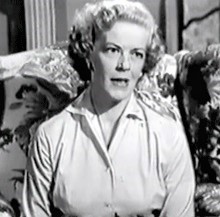
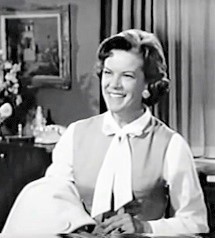
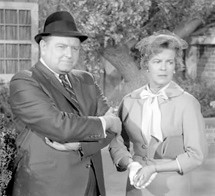
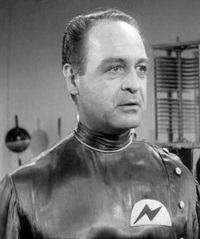 Dudley Manlove (1914-1996, photo at left), the program’s announcer, is an enigma, for no one knew of his whereabouts or circumstances until it was learned he had passed away in San Bernardino, CA from cirrhosis of the liver. Manlove married his second wife, the singer Patty Pritchard, in 1947. They were divorced in 1954. Little more is known of Pritchard following the divorce, though as of 2002 her voice could still be heard on a local San Francisco car dealer’s commercial. An interesting bit of trivia for science fiction genre fans is that Manlove played the alien named Eros from 1959’s Plan 9 from Outer Space. For TV he would guest-star in episodes of Dragnet and Alfred Hitchcock Presents.
Dudley Manlove (1914-1996, photo at left), the program’s announcer, is an enigma, for no one knew of his whereabouts or circumstances until it was learned he had passed away in San Bernardino, CA from cirrhosis of the liver. Manlove married his second wife, the singer Patty Pritchard, in 1947. They were divorced in 1954. Little more is known of Pritchard following the divorce, though as of 2002 her voice could still be heard on a local San Francisco car dealer’s commercial. An interesting bit of trivia for science fiction genre fans is that Manlove played the alien named Eros from 1959’s Plan 9 from Outer Space. For TV he would guest-star in episodes of Dragnet and Alfred Hitchcock Presents.
“Valley of the Moon” begins in an atypical way for a Candy Matson mystery. Rather than answering her phone and being asked to take a case, she learns that her best friend Rembrandt has taken a photo assignment to take pictures of a dude ranch called Valley of the Moon for a brochure they are planning, and asks Candy to accompany him—mainly because she has a car and he doesn’t. Candy readily accepts because she is “tuckered out” from the Christmas holiday and needs a break away from it all. Of course, all is soon revealed as more than the innocent, harmless dude ranch this one presents itself as to outsiders, for a scheme going quickly sideways and out of control among some of the odd assortment of guests, not least of whom are a singing cowboy, an elderly dowager tired of her world-traveling but not the bottom of numerous bottles of liquid sorrow, the owner of the property, and a faithful work hand is soon brought to light. As one might imagine in a murder mystery there is naturally a murder most foul. But who gets offed and why form the crux of the nasty little story you are about to hear, and is what ruins Candy’s hopes for a bit of R&R at the dude ranch called “Valley of the Moon.”
Play Time: 30:54
{Airing on a Monday evening the day after Christmas, the neighborhood gang made a beeline for the corner newsstand the next morning, taking advantage of the final few days of the holiday vacation. With private investigators, mysteries, and detectives still on their minds they made their way to the one wall of shelves holding the detective magazines and saw a few they liked. Detective Tales (1935-53) was one of the detective pulps they could count on, and with a new John D. MacDonald story teased on the cover it was a sure buy. Detective Tales was a monthly in 1949. Dime Detective (1931-53) was Popular Publication’s best-seller of all of its detective pulps. It too attracted top talent which accounted in large measure for its longevity. It was a good month for John D. MacDonald, who saw another of his stories promoted on the cover of the issue below. Dime Detective ran for a monumental 274 issues (most monthly except for its final 3 years). It was a monthly in 1949. F.B.I. Detective Stories (1949-51) made a decent go of it but would close shop after only 14 bi-monthly issues. The heyday of the FBI in books, on radio, and on the silver screen was long over and the once enticing appeal it held during the era of prohibition (1920s-early 30s) and organized crime (1920s-1940s) had lost its attraction through decades of familiarity, especially after WWII.}
[Left: Detective Tales, 12/49 – Center: Dime Detective, 12/49 – Right: F.B.I. Detective Stories, 12/49]

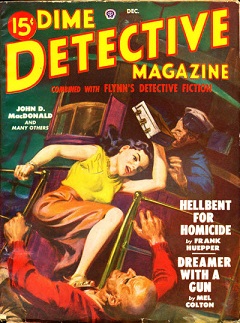
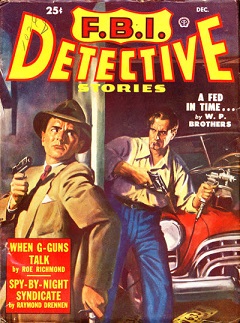
To view the entire list of weekly Old Time Radio episodes at Tangent Online, click here.